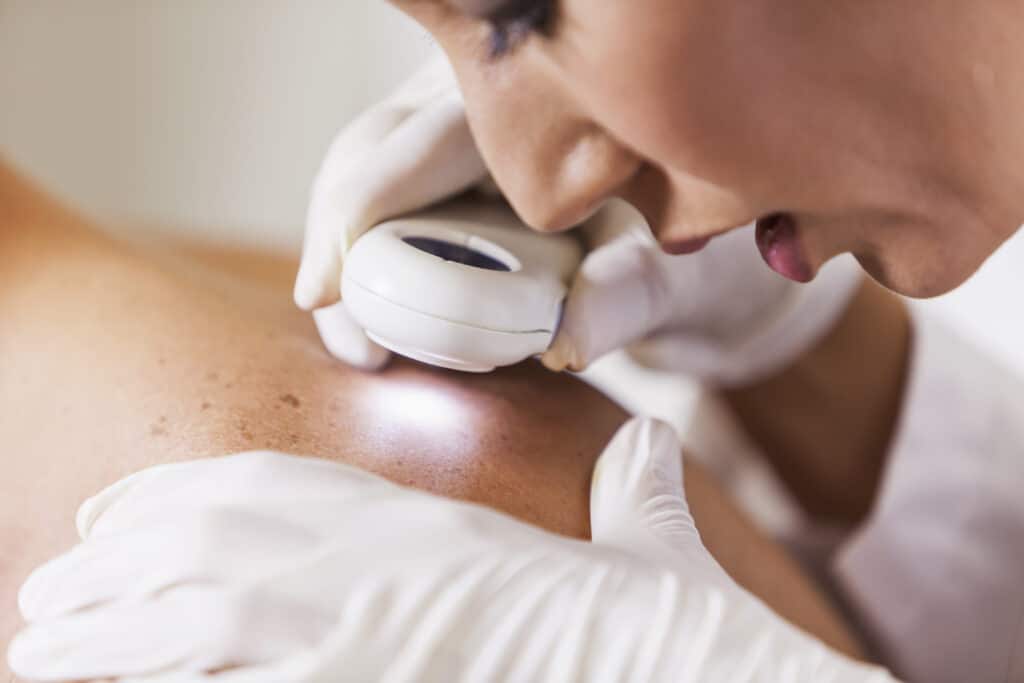Skin cancer is the most common form of cancer in the United States, affecting 1 in 5 Americans in their lifetime. Luckily, skin cancer is highly treatable and has up to a 99 percent survival rate if detected, diagnosed, and treated during the early stages. As more visible forms of cancer, basal cell carcinoma, squamous cell carcinoma and melanoma are typically identified during routine skin exams by a board-certified dermatologist. Self-exams are also important for keeping trackof changes in the skin which may be an early sign of trouble.
Who is most at-risk for developing skin cancer? While skin cancer can affect anyone, these five factors may indicate an increased risk of developing the disease.
Light Skin, Eyes, and Hair
Melanin is a naturally occurring pigment found in the skin, hair, and eyes that helps to protect your body from the damaging effects of the sun. It is also responsible for skin tones, and hair and eye color. Because lighter complexions, eyes, and hair indicate lower levels of melanin, those with these characteristics are naturally more vulnerable to sun damage, which is a primary cause of skin cancer.
This isn’t to say those with darker skin, eyes, and hair are necessarily safe from developing skin cancer. Instead, it means skin cancer may appear in less common areas such as the palms of the hands, soles of the feet, or inside the mouth. This is why it’s so important for everyone to get thorough, full-body skin exams at least once a year. Skin cancer experts like Dr. Brian Mekelburg are highly trained in identifying skin cancer during the earliest stages to give you the best chance at recovery.
Frequent and Prolonged Sun Exposure
While most people understand that prolonged sun exposure is damaging to the skin, you may not realize how deep that damage goes. UV rays can damage the skin on a molecular level, impacting your skin cell’s DNA. As the instruction manual your body uses to produce new cells to keep your skin strong and healthy, this DNA damage can cause mutations that may develop into cancer.
Athletes, nature enthusiasts, people who work outdoors, and others who are often in the sun for extended periods of time must take extra precautions to prevent skin cancer. Simple steps like wearing sunblock or protective clothing can go a long way in saving your skin. You should also avoid being in direct sun during the peak hours of the day when possible.
Age
Just as those who are frequently exposed to the sun have to be proactive in protecting their skin, older adults must also take steps to protect themselves. As we age, our skin becomes thinner and more vulnerable to sun damage. Our skin cells also take longer to heal with age, especially in adults over the age of 50.
Annual skin exams for older adults are a vital part of protecting continued health. This can not only aid in catching skin cancer in the early stages, but help to address any other skin conditions that may develop with age, such as nummular eczema or stasis dermatitis.
Mole-Prone Skin
Though every new mole isn’t necessarily indicative of skin cancer, having mole-prone skin may mean you need to be more vigilant. Skin that already has multiple moles can make it difficult to recognize the difference between typical and atypical growths. Likewise, new moles may not be immediately noticeable, making them less likely to be examined and properly diagnosed as cancerous if necessary.
If you have mole-prone skin, self-examining your skin regularly makes it easier to notice early changes that may indicate a problem. If you notice a concerning change, scheduling an appointment with a board-certified, fellowship trained dermatologist can give you peace of mind. Dr. Mekelburg has over 30 years of dermatology expertise in skin cancer diagnosis and treatment as well as other dermatological conditions.
Personal or Family History of Skin Cancer
One of the most significant skin cancer risk factors is a personal or familial history of the disease. One-tenth of melanoma patients have at least one relative who had also developed skin cancer. Moreover, a previous skin cancer diagnosis increases your chances of relapse at some point in your life.
This is why dermatologists recommend getting a skin exam every six months for at least two years following skin cancer removal or remission. If new cancerous growths are present, early detection offers a wider array of care options including topical treatments and surgical intervention.
Your Next Steps
While there’s no true way to predict who will and won’t develop skin cancer, being mindful of your risk factors can be life saving. If you have one or more of the above risk factors, take proactive steps to ensure your health by using sunscreen, wearing protective clothing, and avoiding staying in the sun too long. If annual skin exams aren’t already a part of your healthcare routine, begin now by scheduling your first exam with Dr. Brian Mekelburg.
Contact us now to book your appointment today.



